|
JANUARY 2020
|
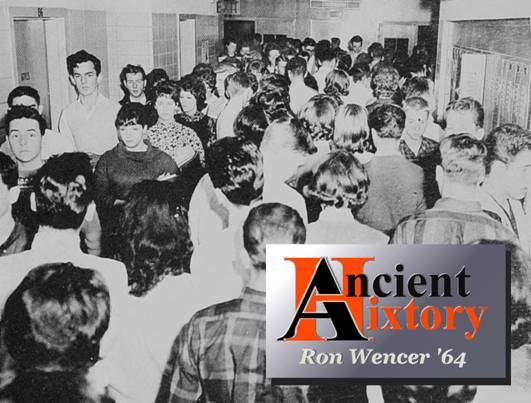
tap...
tap...
|
Introduction
What were high school students thinking about when
they returned from winter break at the start of 1964?
No doubt, some were preparing for the next school show, or
practicing their driving for a road test, or finishing work on the
upcoming yearbook. Seniors
were thinking about careers, and worrying about finding full-time jobs,
or applying to college.
In
Hicksville
, there also was something else on the minds of its students - and on
those of its faculty and school employees.
At any time during any school day, two loud, sharp percussive
noises from the Public Address system - the sound of an assistant
principal's fingernail tapping on a microphone in the Office - might
set everyone in the building in motion.
Like
automatons in a choreographed sci-fi ballet, students would instantly
rise from their seats, gather their things, walk to their hall lockers,
and unlock them. From the
lockers the students would remove and don their winter coats and
footwear, as if it were the end of the day, but they would leave their
lockers open for inspection. They
then would head to the nearest exits, and proceed out through the cold
to designated rendezvous points (e.g., the athletic field, or - in my
case - the then "student parking lot" on
Division Avenue
). As they gathered in these
spots, police cars would already be parked at the school's main
entrance, and the first of the fire trucks would be arriving.
All
of this happened with a certain precision, for it had been done many
times - too many times - before.
It was the routine response when some unidentified caller left
word that a bomb had been planted in the high school.
***
A Worrisome Tradition
None of us who were alive on September 11, 2001
will forget the terrible events of that day.
They changed our world forever, and in their aftermath, our
everyday vocabulary grew to include words like terrorist,
and phrases like Improvised
Explosive Device.
It
is tempting for us to think that before that day, back in our childhood,
life was far more innocent. Although
that belief is true in many ways, greater
New York
has a long history of terrorist incidents and
IEDs. For example, in the
late 19th century, communists and anarchists were active in
western
Queens
. Both sides believed in the
use of violence, including the hiding of bombs in crowded places, to
achieve their aims.
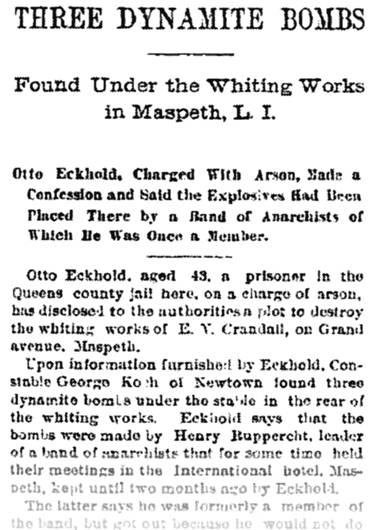
Brooklyn
Daily Eagle, April 11, 1893
Thus, in
the early 1890s, anarchists planted multiple bombs underneath a factory
in Maspeth,
Queens
. Due to strife within the
group - not surprising; the idea of organized anarchists seems at best
a paradox - the plans were leaked to the police, and a date for
detonating the bombs was never set.
*
In 1898, a waterlogged, unexploded pipe bomb was discovered on a beach
in Westhampton. Was it
related to the Spanish-American War?
Was it a failed test bomb for some unknown plot?
No one knew.
*
It is surprising to learn that
Hicksville
once played a small but crucial part in a terrorist incident of
national, even international, significance.
In July 1915, Erich Meunter, believed to have been a German
agent, put a time-bomb in the foyer of the U.S. Senate.
Before it exploded, he was on his way back to
New York
, where he concealed another bomb on a munitions ship bound for
England
. For good measure, he made
a surprise dinnertime visit to a
Long Island
estate and shot J.P. Morgan, but the wounded man managed to overpower
his would-be assassin.
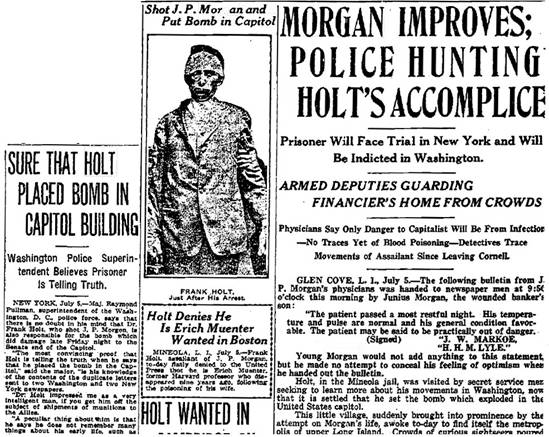
Wife Murderer, Former Professor, and Terrorist:
Erich Meunter, alias Frank Holt
Syracuse
Journal, July 15, 1915
After the suicide of the spy / terrorist, officials
learned that he had constructed his bombs, and practiced his shooting,
at a cottage in
Hicksville
. It is likely that he
gained access to the property by making connections with members of the
hospitable local German-American community.
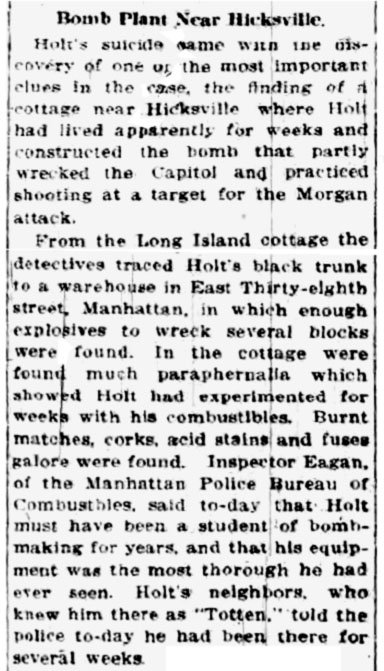
Brooklyn
Daily Standard, July 7, 1915
*
In September 1920, 38 people died, and
hundreds more were injured, when a bomb concealed in a horse-drawn wagon
exploded at noon, across from the offices of J.P. Morgan & Company
at 23 Wall Street. At the
time, it was the worst terrorist attack in the nation's history.
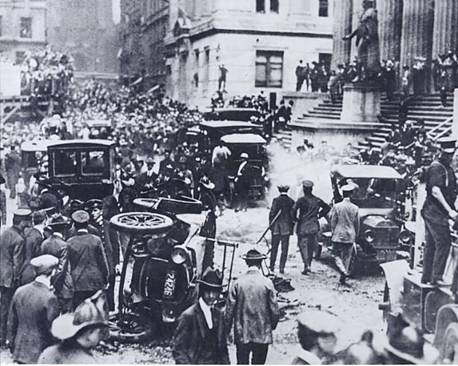
http://en.wikipedia.org/wiki/Image:Wallstreetbmb.jpg
Although the perpetrators were never discovered, it
is believed to have been the work of a known cell of anarchists,
responsible for exploding bombs elsewhere around that time.
*
A decade later, an unexploded live pipe
bomb, filled with shrapnel, was found near the intersection of New South
and Plainview Roads, possibly dumped there when someone had second
thoughts about using it in an attack.
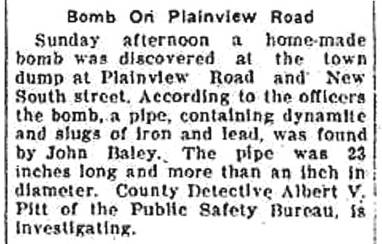
Huntington
Long-Islander, July 25, 1930
*
Bombings were infrequent and unpredictable,
but they never really went away. Criminal
organizations would occasionally use bombs.
One especially notorious criminal bombing occurred in
Queens
in 1931. It targeted neither
a mobster nor his criminal enterprise, but his family while they were at
home. Three young children
were killed by the explosion.
At the 1940
New York
World's Fair, a time-bomb exploded, killing two people.
The person(s) responsible remain unknown.
This was the "last straw" for Mayor Fiorello LaGuardia: he
directed the NYPD to establish a permanent Bomb Squad, and to use expert
knowledge to devise vehicles in which live IEDs could be transported
safely.
*
Older readers will recall, and their children
may remember being told about,
New York
's prolific letter-writing Mad
Bomber. George Metesky,
a quiet, clever, meticulous, and disturbed man, dedicated his adult life
to terrorizing New Yorkers, in hopes of wreaking revenge upon
Consolidated Edison. He
began placing bombs in public places in 1940, but he soon took a hiatus
- a letter to the public explained that it would be unpatriotic for
him to continue to plant bombs in wartime!
Nonetheless, he still wrote letters during World War II, in hopes
that that they would be published. He
resumed his "work" in 1951.
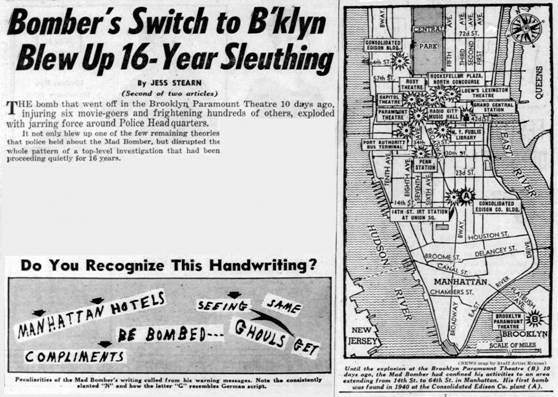
Plea for the Public's Assistance
Excerpts from
New York
Daily News, December 12, 1956
Thanks
to what likely was the first instance of criminal profiling, Metesky
finally was arrested at his
Connecticut
home in 1957. By then, he
had planted 33 bombs in public places.
Some were duds, some were found and disarmed, but 22 of them
exploded, injuring 15 innocent people.
***
Dumb and Dumber, 1950s
Style
Given this history, and given that a madman was
planting real bombs in New York City until the mid-1950s, there were
excellent reasons to take any bomb threat seriously, not matter how
preposterous it might seem - which is precisely what post-war
adolescent pranksters counted on.
Before
the Call Display era,
schools sometimes were victims of telephoned-in "bomb threats."
The callers might be anyone: terrorists (unlikely), cranks,
mentally unstable adults, even students hoping to postpone exams - but
the questionable character of the callers did not mean that there were
no IEDs. Although the public
took to calling the threats "bomb scares" and dismissed them,
authorities could never risk taking the threats lightly.
In the event of such threats, schools would be evacuated, and
local police and fire departments called in to inspect the vacated
premises thoroughly.
*
Early in 1954, a spate of such events occurred in
Nassau
County
. Schools in Port
Washington, Amityville,
Hicksville
, and Roslyn all were threatened, and in some cases, explosive devices
were discovered. In
consequence, sixty-five
Long Island
school superintendents met as a body with police to establish more open
communications. Three Port
Washington students were arrested in one case; one
Hicksville
student was arrested in another.
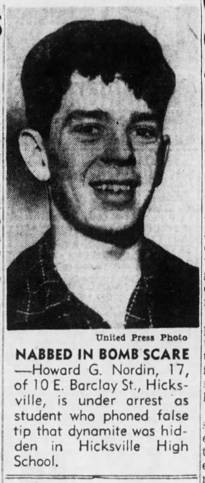
"I
thought it was a good idea," he told the Judge.
Long-Island Star-Journal,
March 26, 1954
The situation in Roslyn, however, proved more worrisome.
A homemade bomb exploded in a hall locker, and the following day,
another one was discovered before it could explode.
More bomb scares hit Hicksville High during the winter of
1954-1955. There was no
option but to continue to evacuate and inspect.
***
A Lull, and Then...
Almost 10 years later,
Hicksville
High School
became the target of a long series of bomb threats.
They received no publicity at first, but as 1964 began, members
of the Board of Education and Nassau County Police spoke to the press
about what the school had had to endure as 1963 waned.
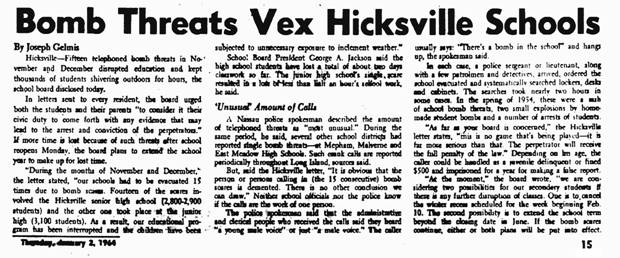
Newsday, January 2, 1964
As the previous year wound down, fifteen separate
incidents had caused evacuations and inspections.
On at least one occasion, two threats had been made on the same
day, each triggering an evacuation.
The President of the School Board (probably assuming that each
incident cost students an hour of class time) stated that two full days
of class work had been lost.
Based
on my personal recollection, that estimate was too optimistic.
It likely did not take into account, for example, that students
often left one class after about 15 minutes, missed a second class
completely, and upon returning to the school had to wait to be told how
the schedule for the rest of the day was being adjusted.
Even in the shortest evacuations, at least one full class and
nearly half of another class was lost.
Moreover, the inspections sometimes took longer - for example,
absent students were not in school to unlock their lockers for
inspection, and police/fire respondents had to determine what might be
in those lockers.
The
bomb threats ceased after Newsday
printed the story, but not immediately.
Three more were called in, bringing the total to eighteen.
By my own unofficial calculation, together all of that year's
evacuations cost me (and many others) a full week of class time.
*
Who was the perpetrator? Rumors
abounded. I was told by a
friend that newspapers had identified "a woman in
Huntington
" as the person responsible, but I could never find the article which
reported that. Other
students blamed a lonely old lady (no one I knew ever saw her or was
told her name) who liked to give snacks to the students.
I was told by someone else that a certain high school senior was
found to have called in the single threat made to the Junior High, but
again, no one else knew anything about it.
As
suddenly as they had begun, the bomb threats of 1963-1964 ceased.
I have searched the Newsday and the Daily News
archives, but I have found no report of anyone's being apprehended for
making them.
***
A Mathematics Problem
If
nearly 3,000 high school students are evacuated to the high school's
grounds 18 times from November through January, for as long as 2 hours
per evacuation, how do they pass the time?
*
Looking back after 56 years, I remember some - not all - things
about the evacuations quite vividly.
Wondering what others might recall, last November I posted a
question to the "You Know You're From Hicksville" group on Facebook.
I thank the many former HHS students who replied.
It
came as no surprise that the novelty of being extricated from class wore
thin quickly, especially if the alternative was standing around in cold
weather. Regardless, though,
people tried to cope.
Had
a sociologist interviewed all of us at the time, s/he might have found
enough fodder for a Masters thesis.
Our evacuation points were based on our locker locations, which
were determined by our homeroom locations, which in turn were determined
by the combination of our class (Senior, Junior, or Sophomore) and the
alphabetic order of our surnames. Thus,
during a bomb scare, although we were free to socialize with the other
students at our designated location, many of them were unknown to us.
The routine's repetitions gave us a chance to form new social
groups ("bomb scare acquaintances"), which tended to gather at the
same spot in each evacuation.
*
One thing mentioned by a number of people on Facebook was the cold. Evacuations
on cold days were especially trying for some people, because of their
personal routines. For
example, it normally took me only two minutes to walk from 188 7th
St. to the high school - which meant that I rarely wore a warm coat,
even in winter. And so, I
got to spend eighteen evacuations wearing a light wind-breaker,
shivering and gazing at the rooftop of my warm house.
In a similar circumstance were students whose parents drove them
to/from school, and those who drove themselves to school (there were not
very many) and also happened to be evacuated to the lot in which they
had parked their cars.
Because
I was always cold, and because I eventually had nothing else to do,
after several bomb evacuations I decided to dance while I waited to go
back inside. Well, not
quite. One day, with the
little student parking lot full of shivering people, someone had the
bright idea of breaking out in song - specifically, Hava
Nagila. Immediately, a
ring of male and female students formed, singing together and dancing.
Of course, I had heard the song, but I knew neither the words nor
the steps (alas, I could never find it in the hymnals at Holy Family
parish). I watched.
Steps? Not a problem.
I tentatively wedged myself into the circle, and began dancing
with people whom I did not know.
As
time went by, the weather got still colder, the bomb scares continued,
and I danced in a lot of horas. By
the time the final bomb threat evacuated us, I could sing all of Hava Nagila phonetically.
***
Conclusion
Bombings continued in New York.
In
the 1970s, as I walking back to my workplace in downtown Manhattan, I
saw the unique NYPD bomb disposal truck parked in front of my building.
I was told "There's another bomb threat at that Federal
office on the 4th floor - they get them all the time, but
there's never any bomb. It's
somebody's idea of a game."
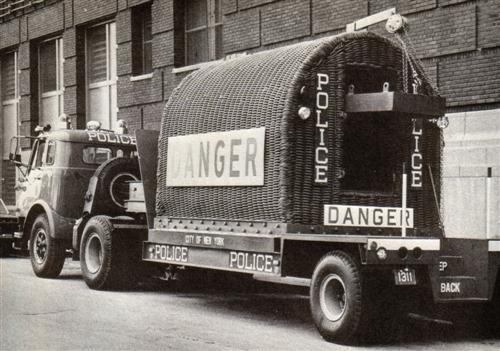
NYPD Bomb Disposal Carrier, 1965 version
http://www.policeny.com/bomb1.html
Months later, a bomb exploded only a few blocks away, at historic
Fraunces Tavern. Later the
same year, another bomb blew through a locker at La Guardia, making
shrapnel that penetrated whatever was in its way.
Between the two blasts - perpetrated by different political
terrorist groups - fifteen people died, and more than one hundred were
seriously injured. It is
unlikely that any of the victims were enemies of those who planted the
bombs.
Alas,
there is more to life than dancing in the cold to mock a bomb that you
know does not exist, and much of it is grim.
Still, I sometimes look back at those eighteen bomb scares, shake
my head at the troubled minds responsible for them, and - despite
myself - I smile when I think of my first hora.
Life goes on.
***
|









